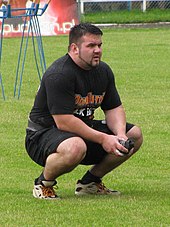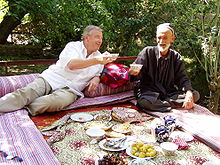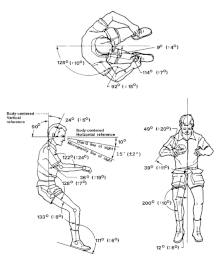This is an old revision of this page, as edited by ClueBot NG (talk | contribs) at 09:39, 27 September 2020 (Reverting possible vandalism by 2A00:23C4:29D:D01:ECB8:1549:E2A3:2897 to version by Srleffler. Report False Positive? Thanks, ClueBot NG. (3785152) (Bot)). The present address (URL) is a permanent link to this revision, which may differ significantly from the current revision.
Revision as of 09:39, 27 September 2020 by ClueBot NG (talk | contribs) (Reverting possible vandalism by 2A00:23C4:29D:D01:ECB8:1549:E2A3:2897 to version by Srleffler. Report False Positive? Thanks, ClueBot NG. (3785152) (Bot))(diff) ← Previous revision | Latest revision (diff) | Newer revision → (diff) Physical configurations of the human body "Pose" redirects here. For other uses, see Pose (disambiguation). "Posing" redirects here. For the municipality in Bavaria in Germany, see Pösing.

Human positions refer to the different physical configurations that the human body can take. There are several synonyms that refer to human positioning, often used interchangeably, but having specific nuances of meaning.
- Position is a general term for a configuration of the human body.
- Posture means an intentionally or habitually assumed position.
- Pose implies an artistic, aesthetic, athletic, or spiritual intention of the position.
- Attitude refers to postures assumed for purpose of imitation, intentional or not, as well as in some standard collocations in reference to some distinguished types of posture: "Freud never assumed a fencer's attitude, yet almost all took him for a swordsman."
- Bearing refers to the manner of the posture, as well as of gestures and other aspects of the conduct taking place.
Basic positions
While not moving, a human is usually in one of the following basic positions:
All-fours
This is the static form of crawling which is instinctive form of locomotion for very young children. It was a commonly used childbirth position in both Western and non-Western cultures, in which context it is known as the Gaskin Maneuver. This position is sometimes viewed as sexually explicit due to its association with sexual initiation or availability.
Kneeling
Main article: Kneeling
Kneeling is a basic human position where one or both knees touch the ground. It is used as a resting position, during childbirth and as an expression of reverence and submission. While kneeling, the angle between the legs can vary from zero to widely splayed out, flexibility permitting. It is common to kneel with one leg and squat with the other leg.
While kneeling, the thighs and upper body can be at various angles in particular:
- Vertical kneel: where both the thighs and upper body are vertical – also known as "standing on one's knees"
- Sitting kneel: where the thighs are near horizontal and the buttocks sit back on the heels with the upper body vertical - for example as in Seiza and Vajrasana (yoga).
- Taking a knee: where the upper body is vertical, one knee is touching the ground while the foot of the other leg is placed on the ground in front of the body.
Lying
Main article: Lying (position)
When in lying position, the body may assume a great variety of shapes and positions. The following are the basic recognized positions.
- Supine position: lying on the back with the face up.
- Prone position: lying on the chest with the face down ("lying down" or "going prone").
- Lying on either side, with the body straight or bent/curled forward or backward.
- Fetal position: is lying or sitting curled, with limbs close to the torso and the head close to the knees.
Sitting
Main article: Sitting
Sitting requires the buttocks resting on a more or less horizontal structure, such as a chair or the ground. Special ways of sitting are with the legs horizontal, and in an inclined seat. While on a chair the shins are usually vertical, on the ground the shins may be crossed in the lotus position or be placed horizontally under the thigh in a seiza.
Squatting or crouching
Main article: Squatting position
Squatting is a posture where the weight of the body is on the feet (as with standing) but the knees and hips are bent. In contrast, sitting, involves taking the weight of the body, at least in part, on the buttocks against the ground or a horizontal object such as a chair seat. The angle between the legs when squatting can vary from zero to widely splayed out, flexibility permitting. Squatting may be either:
- full – known as full squat, deep squat, grok squat, Asian squat, third world squat, (sitting) on one's haunches, (sitting) on one's hunkers, or hunkering (down) etc.
- partial – known as partial, standing, half, semi, parallel, shallow, intermediate, incomplete or monkey squat etc.
Crouching is usually considered to be synonymous with full squatting. It is common to squat with one leg and kneel with the other leg. One or both heels may be up when squatting. Young children often instinctively squat. Among Chinese, Southeast Asian, and Eastern European adults, squatting often takes the place of sitting or standing.
Standing
Main article: Standing
Although quiet standing appears to be static, modern instrumentation shows it to be a process of rocking from the ankle in the sagittal plane. The sway of quiet standing is often likened to the motion of an inverted pendulum. There are many mechanisms in the body that are suggested to control this movement, e.g. a spring action in muscles, higher control from the nervous system or core muscles.
Although standing isn't dangerous per se, there are pathologies associated with it. One short term condition is orthostatic hypotension, and long term conditions are sore feet, stiff legs and low back pain.
Contexts
Asanas
Main article: List of asanasCertain asanas were originally intended primarily to restore and maintain a practitioner's well-being, improve the body's flexibility and vitality, and promote the ability to remain in seated meditation for extended periods.
Atypical positions
Atypical positions include:
- standing on one leg
- handstand
- head stand
- spreadeagle
- crab position
- Humans can hang in various positions. It is a position where the support is above the center of gravity. It may be voluntary or involuntary.
Such positions are common to break dancing, gymnastics and yoga.
Bondage positions
Main article: List of bondage positionsA bondage position is a body position created by physical restraints which restricts locomotion, use of the limbs or general freedom of movement.
Childbirth positions
Main article: Childbirth positionsIn addition to the lithotomy position still commonly used by many obstetricians, childbirth positions that are successfully used by midwives and traditional birth-attendants the world over include squatting, standing, kneeling and on all fours, often in a sequence.
Dance positions

Dance position is a position of a dancer or a mutual position of a dance couple assumed during a dance. Describing and mastering proper dance positions is an important part of dance technique.
Defecation positions
Main article: Defecation positionsThe two most common defecation positions are squatting and sitting. The squatting posture is used for Japanese, in countries with a Muslim or Hindu majority and in the absence of toilets or other devices. The sitting defecation posture is used in Western toilets, with a lean-forward posture or a 90-degrees posture.
Eating positions
Main article: Eating
Eating positions vary according to the different regions of the world, as culture influences the way people eat their meals. For example, most of the Middle Eastern countries, eating while sitting on the floor is most common, and it is believed to be healthier than eating while sitting to a table.
Eating in a reclining position was favored by the Ancient Greeks at a celebration they called a symposium, and this custom was adopted by the Ancient Romans. Ancient Hebrews also adopted this posture for traditional celebrations of Passover.
Heat escape lessening position
Main article: Heat escape lessening positionThe heat escape lessening position (HELP) is a way to position oneself to reduce heat loss in cold water. It is taught as part of the curriculum in Australia, North America and Ireland for lifeguard and boating safety training. It essentially involves positioning one's knees together and hugging them close to the chest using one's arms.
Medical positions

The following positions are specifically used in medicine:
- Anatomical position
- Bozeman's position
- Decubitus position
- Fowler's position (also Semi-Fowler position)
- High Fowlers position
- Knee-chest position
- Knee-elbow position
- Lithotomy position
- Mayer position
- Rose's position
- Semi-Fowler position
- Sims' position
- Trendelenburg position
- Verticosubmental position
- Waters' position
Microgravity
Main article: Microgravity
In microgravity, the human body naturally adopts the neutral body posture.
Recovery position
Main article: Recovery positionThe recovery position or coma position refers to one of a series of variations on a lateral recumbent or three-quarters prone position of the body, into which an unconscious but breathing casualty can be placed as part of first aid treatment.
Resting positions
Main article: Resting positionA large number of resting positions are possible, based on variations of sitting, squatting, kneeling or lying.
Riding positions
See also: Equestrianism, Cycling, and Motorcycling
A "straddle" or "astride" position is usually adopted when riding a horse, donkey, or other beast of burden, with or without the aid of a saddle. The position is also used for sitting on analogous vehicles and furniture, such as bicycles, motorcycles, or unicycles, and certain types of specialized workbenches (such as a shaving horse). By definition, an essential feature is having one leg on each side of whatever is being straddled. The related sidesaddle position allows riding without straddling, but is somewhat less secure against accidental dismounting or falling.
The straddle posture is often intermediate between standing and sitting positions, allowing body weight to be supported securely, while also affording a high degree of upper body mobility and dynamic balance during vigorous or extended motions.
Sex positions
Main article: Sex positionsSex positions are positions which people may adopt during or for the purpose of sexual intercourse or other sexual activities. Sexual acts are generally described by the positions the participants adopt in order to perform those acts.
Shooting positions
See also: Shooting and Three positions- Kneeling position
- Prone position
- Standing position
- Sitting
- Squatting
Sleeping positions
Main article: Sleeping positionsThe sleeping position is the body configuration assumed by a person during or prior to sleeping. Six basic sleeping positions have been identified:
- Fetus (41%) – curling up in a fetal position. This was the most common position, and is especially popular with women.
- Log (15%) – lying on one's side with the arms down the side.
- Yearner (13%) – sleeping on one's side with the arms in front.
- Soldier (8%) – on one's back with the arms pinned to the sides.
- Freefall (7%) – on one's front with the arms around the pillow and the head tilted to one side.
- Starfish (5%) – on one's back with the arms around the pillow.
Stress positions
Main article: Stress positionsStress positions place the human body in such a way that a great amount of weight is placed on just one or two muscles. Forcing prisoners to adopt such positions is a method of ill-treatment used for extracting information or as a punishment, possibly amounting to torture. Such positions also are sometimes used as a punishment for children.
Submissive positions
Submissive positions are often ceremonial and dictated by culture. They may be performed as a mutual sign of respect between equals or as a sign of submission to a higher-ranking individual or to a ceremonial object.
- Bowing is the lowering of the head and torso towards the person or object of reverence, often briefly. The extent of a bow ranges from a simple head nod to a 90–degree bending at the waist. Though less common in Western cultures, it remains an important sign of respect in many Eastern cultures, and is also used in the ceremonies of various religions.
- In bowing and scraping, the right hand is placed across the abdomen while the right leg is drawn or "scraped" back during a bow.
- In Western cultures, it is often considered proper for women to perform a curtsey by bending the knees instead of a bow.
- Genuflection (or genuflexion) is bending at least one knee to the ground, was from early times a gesture of deep respect for a superior.
- Kneeling is associated with reverence, submission and obeisance.
- Kowtowing is the act of deep respect shown by kneeling and bowing so low as to have one's head touching the ground.
- Prostration is the placement of the body in a reverentially or submissively prone position.
Urination positions
Main article: UrinationFor men, because of the flexible and protruding nature of the penis, it is simple to control the direction of the urine stream. Many men urinate in a standing position although they can also urinate sitting down or squatting.
For women, the urine direction is harder to control. Women most commonly urinate sitting or squatting, depending on the type of toilet. Many women are able to urinate standing, sometimes using a female urination device.
See also
- Abnormal posturing
- Anatomical terms of location
- Alexander Technique
- Contortionism
- Ergonomics
- Feldenkrais Method
- Gait (human)
- Human anatomical terms
- Mitzvah Technique
- Neutral spine
- Positional asphyxia
- Posture release imagery
- Rolfing Structural Integration
- Terrestrial locomotion in animals
References
- "Position." Dictionary.com, Unabridged (v 1.1). Random House, Inc. 24 October 2007. Reference.com
- Fritz Wittels (1995). Freud and the Child Woman: The Memoirs of Fritz Wittels. Yale University Press. p. 49. ISBN 978-0-300-06485-8.
- ^ G.J. Engelmann (1883). Labor Among Primitive Peoples, St. Louis: J.H. Chambers. pp, 89-93. (Engelmann calls this the knee-hand or knee-elbow position)
- Sacomori, Cinara; Fernando Luiz Cardoso (2010). "Sexual initiative and intercourse behavior during pregnancy among Brazilian women: a retrospective study". Journal of Sex & Marital Therapy. 36 (2): 124–136. doi:10.1080/00926230903554503. PMID 20169493.
- ^ Hewes, GW (April 1955). "World distribution of certain postural habits". American Anthropologist. 57 (2): 231–44. doi:10.1525/aa.1955.57.2.02a00040. JSTOR 666393.
- Dobrzynski, Judith H. (17 October 2004). "An Eye on China's Not So Rich and Famous". The New York Times. Retrieved 7 April 2010.
- Abstract "Kinematic and kinetic validity of the inverted pendulum model in quiet standing", NIH
- Donovan, Sandy (2010). The Middle Eastern American Experience. United States: Twenty-First Century Books. p. 68. ISBN 9780761363613.
- Brito, Leonardo Barbosa Barreto de; Ricardo, Djalma Rabelo; Araújo, Denise Sardinha Mendes Soares de; Ramos, Plínio Santos; Myers, Jonathan; Araújo, Claudio Gil Soares de (13 December 2012). "Ability to sit and rise from the floor as a predictor of all-cause mortality". European Journal of Preventive Cardiology. 21 (7): 892–898. doi:10.1177/2047487312471759. ISSN 2047-4873. PMID 23242910.
- "The Roman Banquet". The Met. Metropolitan Museum of Art. Retrieved 13 April 2019.
- "Reclining". A Virtual Passover. Retrieved 13 April 2019.
- Lore, Marybeth (March 2017). "Umbilical Cord Prolapse and Other Cord Emergencies". The Global Library of Women's Medicine. doi:10.3843/GLOWM.10136.
- "knee-chest position". The Free Dictionary Medical Dictionary.
Further reading
- Hewes GW: "The anthropology of posture" Scientific American, 196: 122–132 (1957)
- Instinctive sleeping and resting postures: an anthropological and zoological approach to treatment of low back and joint pain
External links
 Media related to Human positions at Wikimedia Commons
Media related to Human positions at Wikimedia Commons